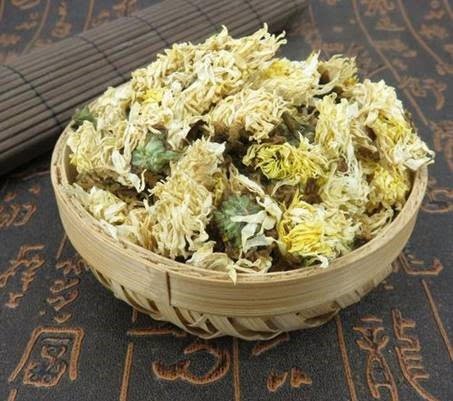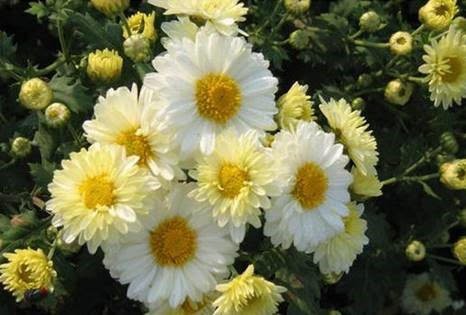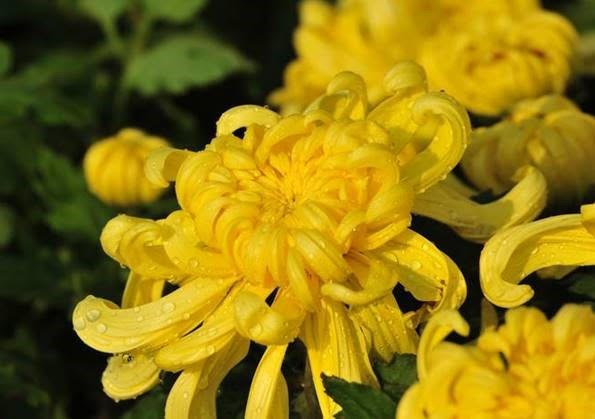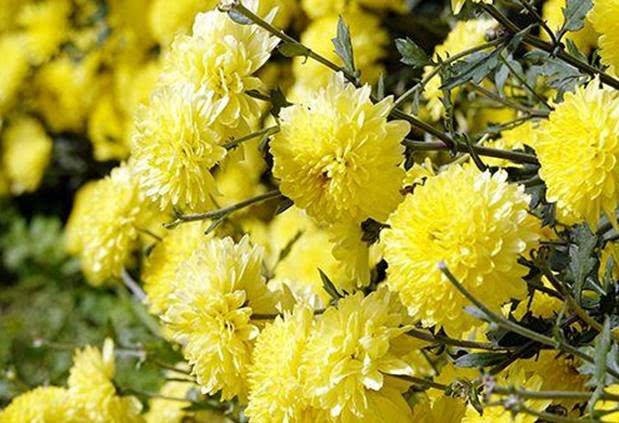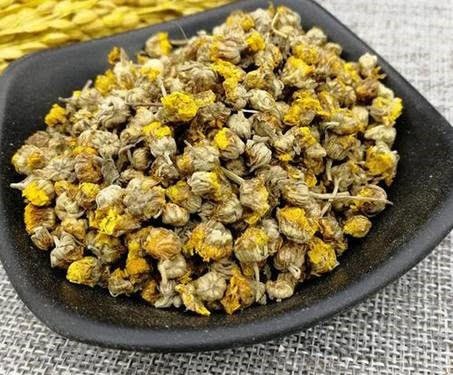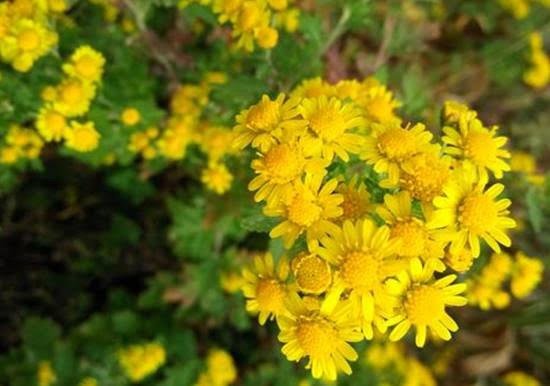Learn About Chinese Herbs -Ju Hua (Chrysanthemum Flower)-
Chrysanthemum Flower include Wild Chrysanthemum Flower
This product is commonly used in traditional Chinese medicine. "Shennong's Materia Medica" is listed as the top grade. According to the different production areas, the goods are divided into several kinds such as Bo Ju, Chu Ju, Gong Ju, Hangzhou Ju, Huai Ju, and Huang Ju.
Synonyms: white chrysanthemum, chamomile flower.
Source: Chrysanthemum moriforium Ramat., a perennial herbaceous plant in the Asteraceae family of dried capitate inflorescences. Cultivated.
Origin: all over the country are produced and introduced to each other.
· Bo chrysanthemum: mainly produced in Bo County, Anhui Province, Wuyang and Shangqiu, Henan.
· Chu chrysanthemum: mainly produced in Chu County, Anhui Province.
· Gong chrysanthemum: (Hui chrysanthemum) is mainly produced in She County, Anhui Province.
· Hang chrysanthemum: (white tea chrysanthemum) is mainly produced in Tongxiang, Zhejiang, Haining.
· Chrysanthemum: mainly produced in Qinyang, Henan, Wuzhi.
· Yellow chrysanthemum: (two sizes) mainly produced in Zhejiang, Haining.
· Sichuan chrysanthemum: the main production of Sichuan Zhongjiang.
Harvesting: In November, when the flowers are in full bloom. The various chrysanthemum processing methods are as follows,
· White chrysanthemum: Cut off the flower branches, bundle them into small bundles, hang them upside down in the shade, and then cut off the flower heads.
· Chu chrysanthemum: the department picks the head inflorescence, smoked by sulfur, dried into 6 into dry, sieve with a sieve, make it into a round spherical shape, and then dry.
· Gong chrysanthemum: Dried with fire after picking the flowers.
· Hang chrysanthemum, Yellow chrysanthemum (big) : after picking the flowers, steamed in the steamer and dried, and the Yellow chrysanthemum (small) is dried with fire.
Trait identification: capitate inflorescence, outer petals (tongue-like flowers) are mostly flattened monolithic. There is a yellow disc-shaped center in the middle (mostly tubular flowers are aggregated) and a green pedicle at the base, which is composed of 3~4 layers of leaves (total bracts). The gas is fragrant, sweet and slightly bitter. Due to the different production areas and processing methods (the actual varieties are different), the products vary slightly from place to place.
Bo chrysanthemum: the flowers are large and thick, the petals are long and tight, about 1~2cm long. Arrangement of the corolla on the pedicle are of equal thickness. Color: White.
Chu chrysanthemum: similar in shape to Bo chrysanthemum, but the flowers are smaller. It is pompom-shaped and loose.
Gong chrysanthemum: The flowers are small, the petals are dense and short, and the color is white. The pedicle is green and vivid, and the heart is golden yellow.
Hang chrysanthemum: due to processing and steaming, it is compacted. The petals are wide and sparse. The color is white and yellowish, with a large center and dark yellow. Steamed yellow feverfew is similar to it, except that the petals are yellow.
Huai chrysanthemum and Chuan chrysanthemum: the flower has large petals and long petals. It is about 1~2cm, mostly yellowish-white, with light red or brownish-red petals. The flower core is small, light brown, loose and soft.
Yellow Chrysanthemum (Bacanized Yellow Feverfew): It is a small capitate inflorescence or unopened flower bud of Yellow Chrysanthemum.
The white chrysanthemums are all white, the flowers are complete, the petals are not scattered, the aroma is strong, and the stalkless leaves are preferred. Yellow chrysanthemums are preferably yellow.
Main ingredients: contains adenine, syrucine, choline, etc., and contains volatile oils.
Pharmacological effects: dissipate wind and cold, detoxify, brighten eyes, the principle is,
(1) Anti-inflammatory, diuretic.
(2) Antibacterial: Chrysanthemum has inhibitory effect on Staphylococcus aureus, B hemolytic streptococcus, dysentery bacillus sonnei, typhoid bacillus and so on in vitro.
In addition, white chrysanthemum has different degrees of inhibition against various skin fungi such as Trichophyton chromophyton in vitro.
Preparation: raw or charcoal.
Taste: sweet, bitter, slightly cold.
Meridian: into the lungs and liver meridians.
Function: Remove wind and heat, clear the liver and eyes.
Used to treat: wind heat fever, dizziness, headache and eye redness.
Clinical application
All kinds of chrysanthemums have different degrees of dissipation of wind heat, antipyretic, detoxification (anti-inflammatory), eye brightening and other effects, but each has its own strengths.
· Chamomile flower (white chrysanthemum) has a good effect on nourishing the liver and brightening the eyes, and is often used for the difficulty seeing caused by liver and kidney yin deficiency.
· Chu chrysanthemum is a kind of white chrysanthemum, with the same function, its quality is better, and the effect of analgesia and sedation is better.
· Hang chrysanthemum (yellow chrysanthemum) has a good ability to evacuate wind heat, and is often used for external wind heat, headache, and redness.
· Wild chrysanthemum has a strong ability to clear heat and detoxify, and is good at treating boils, swelling and poison (see the next article for details).
The specific uses are as follows,
(1) It is used for extraterritorial wind heat. Hangzhou chrysanthemum with Sang Ye, Bo He, etc.
(2) It is used to treat wind-heat eye pain (conjunctivitis). Hang chrysanthemum with Bai Li Ji, Mu Zei, decoction in water, can also be used with its hot steam smoked eyes.
(3) It is used to treat headache caused by hyperactivity of liver yang (equivalent to headache in the early stage of hypertension). Chamomile flowers with Xia Ku Cao, Gou Teng, etc.
(4) It is used to treat dizziness and dizziness caused by liver and kidney insufficiency (such as chronic hepatitis and optic neuritis). Chamomile flowers with wolfberries, such as in Qi Ju Di Huang Wan formula.
Dosage: 3~18g.
Prescription examples
· Qi Ju Di Huang Tang (from "Yi Ji"): Gou Qi Zi 12g, Gan Ju Hua 9g, Shu Di 15g, Fu Ling 9g, Huai Shan 12g, Ze Xie 9g, Shan Yu Rou 9g, Dan Pi 6g, water decoction.
Note: The above chrysanthemums are all medicinal chamomile, but Bo chrysanthemum and Huai Ju are the mainstays, and it is customary to think that Bo Ju is better than Huai Ju. Hang Ju was originally operated by a tea shop, and was mostly used for tea, so it was called tea chrysanthemum. Chu chrysanthemum has a strong aroma and is elegant, and is a treasure in chrysanthemums (in the past, mung bean flour was sprinkled during processing). Gongju is called "Chu Ju" in Beijing, Tianjin and Fujian, and is also used for tea. Yellow chrysanthemum, Beijing and Tianjin are accustomed to using rhubarb chrysanthemum. In the application, each with the doctor's prescription. In terms of efficacy, Hang Ju and Huang Ju are used for wind dissipation and heat dissipation, and white chrysanthemum and Chu Ju (Gong Ju) are used for aiding liver and brightening eyes.
Wild Chrysanthemums Flower
Source: Chrysanthemum indicum L. of dried capitate inflorescences.
Origin: Wild in most parts of the country.
Trait identification: capitate inflorescence, slightly spherical, much smaller than chamomile flowers, about 5~8mm in diameter. The flowers are yellow, with many tubular flowers in the center, and the bracts are glandular. The qi is weak and slightly bitter.
Main ingredients: Contains chrysanthemum flavonoid glycosides, chrysanthemum glycosides, chrysanthemum lactones, pyrethrosides A, B, a small amount of volatile oil, etc.
Pharmacological effects: clear away heat and detoxify, lower blood pressure, the principle is
(1) Antibacterial: It has an inhibitory effect on Staphylococcus aureus and diphtheria bacillus.
(2) Antihypertensive: Animal experiments have confirmed that it has a significant blood pressure lowering effect, and its principle is anti-adrenaline, dilating peripheral blood vessels and inhibiting vascular motor centers.
Taste: bitter, pungent.
Meridians: into the lungs, liver, and kidneys.
Function: Clearing heat and detoxifying.
Main Uses: carbuncle swelling, boils, sores, internal and external washing.
Clinical application
(1) It is used to treat boils and swelling (boils). It is used with wild chrysanthemum for a single flavor, or with Jin Yin Hua, Pu Gong Ying, etc., such as wild chrysanthemum soup.
(2) It is used to treat high blood pressure. Wild chrysanthemum is brewed with boiling water instead of tea, or with Cao Jue Ming and Xia Ku Cao, and decoction in water.
Dosage: 9~18g dried。 30g of fresh products.
Prescription examples
· Ye Ju Tang Formula: wild chrysanthemum 30g, Jin Yin Hua 60g, Pu Gong Ying 30g, Zi Hua Di Ding 30g, decoction in water.
Note: Wild chrysanthemum and chrysanthemum are two different drugs. Wild chrysanthemum is also known as "bitter barley". Li Shizhen: "Bitter barley" is very wild everywhere, no different from chrysanthemum, but the leaves are thin and small and pointed, the flowers are small and the stamens are many, such as honeycomb, and the smell is bitter and spicy. According to this, chamomile flowers are different from wild chrysanthemum flowers and should be used separately medicinally and should not be confused.
Case study: colitis
Patient: Mr. Chen. Age 41.
Chief complaints: patient have had colon disease for nearly four years. Rectal ulcers, erosions, and bloody stools. Patient sought medical treatments at several hospitals, but the condition was not improved.
TCM prescription: Hou Pu 10g, Su Ye 10g, Da Fu Pi 10g, Jie Gen 10g, Dang Shen 10g, Fu Ling 10g, fried Bai Zhu 10g, Gan Cao 3g, Huo Xiang 10g, to make decoction, one dose per day for twenty consecutive doses.
Patient feedback: the bleeding has stopped, and the patient is feeling much better.
Disclaimer: All above articles are for reference only. If patients are interested, please consult a professional practitioner Traditional Chinese Medicine for a consultation.

